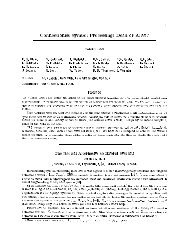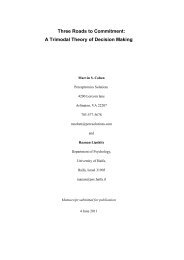Three Roads to Commitment: A Trimodal Theory of Decision Making
Three Roads to Commitment: A Trimodal Theory of Decision Making
Three Roads to Commitment: A Trimodal Theory of Decision Making
Create successful ePaper yourself
Turn your PDF publications into a flip-book with our unique Google optimized e-Paper software.
<strong>Three</strong> <strong>Roads</strong> <strong>to</strong> <strong>Commitment</strong>: A <strong>Trimodal</strong> <strong>Theory</strong> <strong>of</strong> <strong>Decision</strong> <strong>Making</strong> 43<br />
negatively accelerated, and the curves for weak methods, which are S-shaped. Strong methods show decreasing<br />
returns at relevant time scales as deliberation continues. In strong methods, the information known <strong>to</strong> be most<br />
relevant or easiest <strong>to</strong> obtain is likely <strong>to</strong> be acquired early, because they are guided by specific secondary questions;<br />
information acquired later is likely <strong>to</strong> have less impact. By contrast, returns initially increase over time at relevant<br />
scales when weak methods are used, as decision makers learn how <strong>to</strong> make decisions in the relevant domain. For<br />
example, <strong>to</strong>p-down weak methods require analytical modeling, in which elements and relationships are identified<br />
and perhaps quantified. No results are available until the process is complete and results are computed. Bot<strong>to</strong>m-up<br />
methods require learning new concepts and relationships in a new domain – effort that does not pay <strong>of</strong>f until a<br />
critical mass <strong>of</strong> useful knowledge is obtained. In both cases, the primary value <strong>of</strong> early phases is <strong>to</strong> find out what<br />
questions <strong>to</strong> ask; benefits are realized after relevant fac<strong>to</strong>rs are identified and information about them is obtained.<br />
With repeated use <strong>of</strong> the same method in the same problem domain , what is learned may be reapplied on<br />
subsequent occasions, gradually increasing the “strength” <strong>of</strong> the method.<br />
-----------------------------------------------------------<br />
Insert Figure 6 about here<br />
-----------------------------------------------------------<br />
The two parts <strong>of</strong> Figure 6 reflect another qualitative difference, between situations in which the available<br />
methods can deliver similar levels <strong>of</strong> success after sufficient investment <strong>of</strong> time (Figure 6A), versus situations in<br />
which they cannot (Figure 6B). Figure 6A provides an unambiguous ordering <strong>of</strong> methods in terms <strong>of</strong> efficiency,<br />
which is unaffected by the amount <strong>of</strong> time invested or the target level <strong>of</strong> success. In Figure 6B, by contrast, strong<br />
methods can be surpassed by weak methods, and fast versions by slow versions, over long periods <strong>of</strong> time. In this<br />
extreme case, the most efficient methods at short time intervals are the least efficient over longer periods <strong>of</strong> time,<br />
and we can rank order methods by efficiency only relative <strong>to</strong> a fixed decision deadline or target accuracy level. 18<br />
The efficiency curves for assumption-based reasoning may resemble those for strong methods when peripheral<br />
18 Hypotheses about the shapes <strong>of</strong> affordance functions can be experimentally tested by posing decision problems,<br />
constraining participants <strong>to</strong> respond within experimentally varied response windows, and plotting accuracy (e.g.,<br />
appropriateness <strong>of</strong> the response, expected utility <strong>of</strong> consequences, or performance record) against time spent making<br />
the decision. TDM predicts that negatively accelerated curves (i) are more likely <strong>to</strong> be observed in familiar<br />
problems, and (ii) are characteristic <strong>of</strong> methods that do not transfer readily <strong>to</strong> different problems or domains (i.e.,<br />
they represent strong methods); and that S-shaped curves (i) are more likely <strong>to</strong> be observed in unfamiliar problems,<br />
and (ii) are characteristic <strong>of</strong> methods that do transfer <strong>to</strong> different problems or domains (i.e., they represent weak<br />
methods).




